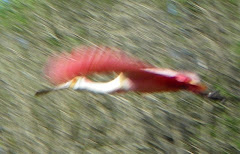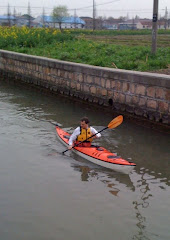
Kayaking in China with our Chinese friends was an opportunity not to be missed! Our first excursion is on the Huang Pu River in an area where large barges on the main river transfer sand to smaller barges that can navigate the maze of narrower waterways that break the flat land into a mosaic.

Paul watches sand fall into an already heavily laden barge.

A line of moored sand barges stretch into the hazy distance...
We turn from the main river into a canal and explore a route through small villages and farmland


Richard passes a pig-pen on the left and chickens to the right, and heads for the setting sun.


We pull from the river near a bridge where our truck driver will find us. Jasmine (left) and Young play with their shoes while they wait.

The Bund... Our second trip proved to be more spicy! Finding a place to launch in Shanghai close to the historic Bund district is not easy! But the rewards made it worth the search. At night the tall buildings of the Pudong district across the river are lit with colorful lights. Brightly lit ferries and tour boats cross paths with commercial barges and ships, while house-sized TV screens on barges show adverts!
The busy traffic kept us dodging, while wakes rebounded from the river walls and docks. The five of us kept close together for safety; five sets of eyes on the lookout for the next boat sliding away from a dock into the darkness.

Lina and Nigel... (with Richard, Paul and Staffan)... our truck driver somehow left all our paddling clothes at the factory and brought only kayaks and paddles...

Eventually we were spotted by police, and two police boats with sirens and flashing lights cornered us agaist the sea wall. With searchlights trained on us they shouted instructions through a megaphone in Chinese. We never made it back to our launch place.

On the phone, our Chinese legal representative translated for us. We were put ashore from the police boat onto a ferry ramp. Free again, we retreated with our kayaks to the nearest street.
(the group from left; Staffan, nigel, Paul, Richard and Lina.)




























































